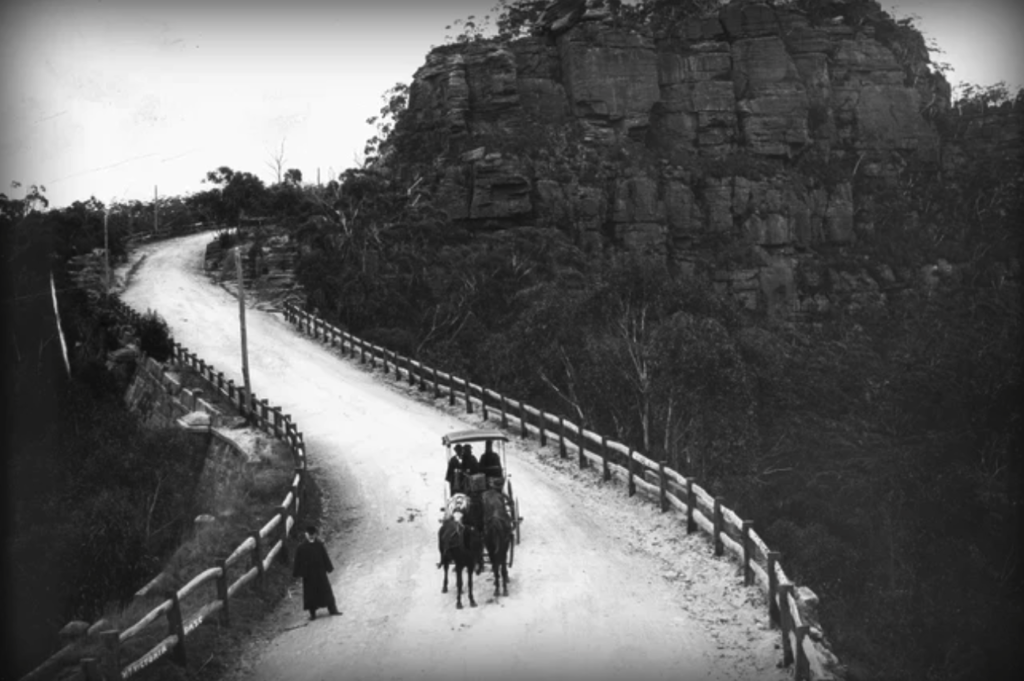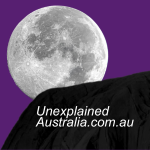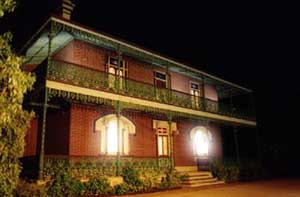
The Ghost of Victoria Pass
By Murray Byfield
“You’d call the man a senseless fool, —A blockhead or an ass,
Who’d dare to say he saw the ghost
Of Mount Victoria Pass.
But I believe the ghost is there,
For, if my eyes are right,
I saw it once upon a ne’er-
To-be-forgotten night.”
The verse above comes from “The Ghost at the Second Bridge” (*see entire poem below) written by the famous Australian bush poet Henry Lawson, regarding the ghost of the Lady in Black which has been witnessed by numerous people travelling along the Great Western Highway in the Blue Mountains, New South Wales.
The ghost of the Lady in Black is said to be that of Caroline Collitt (nee James) whose body was found near Victoria Pass, a very precarious convict constructed bridge in the Blue Mountains which leads to the historic village of Hartley.
The apparition is often described as wearing a black early Victorian style dress, pale skin with long black hair to her waist, she crosses the road and vanishes down a bush track, she is often reported headless.
Lawson in his poem describes her thusly:
“And she is dressed in black;
Her face is white, a dull dead white
Her eyes are opened wide
She never looks to left or right,
Or turns to either side.”
Caroline was only 17 years of age at the time of her brutal murder. She married William Collitt in 1840 and had only been married about eighteen months at the time of her untimely death. William owned a significant number of cattle but was generally considered a person of weak mind. The Collitt family owned the “Collitts Inn” at Mount York on the Cox Pass road beyond Mount Victoria established in 1824.
Caroline’s short life was already somewhat tragic, her mother was known as a notorious drunkard, who hanged herself in her own house. Her father was present at the time but was so inebriated himself that he could not prevent Caroline’s mother from taking her own life. He spent six months in gaol under suspicion of her death but was eventually discharged.
Approximately six months before her mother’s death Caroline’s younger sister married an ex-convict by the name of John Walsh. Walsh was transported to the colony for seven years in 1833. Since his arrival he had been tried twice for murder. Once in 1836 for the murder of a man named Crate but was subsequently acquitted. Another for the murder or a woman and her little boy in 1839.
In this case he was acquitted on account of the character of the principal witness against him. In this case it appears at the woman’s residence a keg of rum and some tobacco was attempted to be stolen. The woman and her son had been beaten to death with a stick which was found near their bodies. Walsh later returned with an indigenous man after the murders to collect the goods from where they had stashed it. They claimed that the murders were committed by bushrangers who had also informed them where the booty was hidden.
Getting back to Caroline’s murder. It appears that during Walsh’s trial that Caroline and her sister were believed to be both “very loose characters”. And that Caroline had left her husband William to move in with her sister and Walsh. Rumours of a ménage-a-trois ensued, and it was believed that Caroline had even been in a previous relationship with Walsh before her sister eventually married him. At the time of her murder, it is believed that Caroline was intending to move back in with her husband William Collitt.
On the day of Caroline’s murder, it was proved that Caroline, William and Walsh were in company with one another and had been drinking at the public house of Joseph Jagger at the foot of Mount Victoria, apparently all were sober when they arrived, however Walsh had been drinking previously. Walsh reportedly had two glasses of brandy, which intoxicated him. William Collitt had one, with Caroline only having a drink of lemon syrup. After leaving the pub Walsh without provocation knocked William down, his life was saved by Caroline who seized Walsh, allowing her husband to escape. This was the last time Caroline was seen alive, her last words to her husband were “Run, he has got a stone and will murder you!”
About a mile from where William fled for his life, her body was found on the following morning 4th of January 1841, by the mailman delivering to Hartley. Her face and head covered with blood and bruises and a frightful wound in the temple, which had penetrated the brain. Which had been evidently been inflicted by a sharp jagged stone, one corner of which fitted into the wound, which was clotted with blood and hair.
Walsh was found guilty and sentenced to death by Mr Justice Stephen at the Bathurst Assizes in April 1842. He was hanged for murder at Bathurst on the 3rd of May 1842.
Caroline and her husband William, his parents and three brothers are all buried in unmarked graves in Forbes Cemetery.
To this day the “Lady in Black” is still reported by people crossing Victoria Pass, including numerous truck drivers. She is apparently witnessed more in winter than summer, when the “black ice” forces motorists to slow down.
The Ghost at the Second Bridge
by Henry Lawson
YOU’D call the man a senseless fool, —
A blockhead or an ass, —
Who’d dare to say he saw the ghost
Of Mount Victoria Pass.
But I believe the ghost is there,
For, if my eyes are right,
I Saw it once upon a ne’er
To-be-forgotten night.
‘Twas in the year of eighty-nine —
The day was nearly gone,
The stars were shining, and the moon
Is mentioned further on; —
I’d tramp’d as far as Hartley Vale
Tho’ tired at the start,
But coming back I got a lift
In Johnny Jones’s cart.
‘Twas winter on the mountains then, —
The air was rather chill,
And so, we stopped beside the inn
That stands below the hill.
A fire was burning in the bar,
And Johnny thought a glass
Would give the tired horse a spell
And help us up the Pass.
Then Jimmy Bent came riding up, —
A tidy chap was Jim, —
He shouted twice, and so of course
We had to shout for him.
And when at last we said good night
He bet a vulgar quid
That we would see the ‘ ghost in black,’
And sure enough we did.
And as we climbed the stony pinch
Below the Camel Bridge
We talked about the ‘ Girl in black ‘
Who haunts the Second Bridge.
We reached the fence that guards the cliff
And passed the corner post,
And Johnny like a senseless fool
Kept harping on the ghost.
She’ll cross the moonlit road in haste
And vanish down the track;
Her long black hair hangs to her waist
And she is dressed in black;
Her face is white a dull dead white—
Her eyes are opened wide, —
She never looks to left or right,
Or turns to either side.
I didn’t b’lieve in ghosts at all,
Tho’ I was rather young,
But still I wished with all my heart
That Jack would hold his tongue.
The time and place, as you will say
(Twas twelve o’clock almost)—
Were both historically favourable
for a ghost.
But have you seen the Second Bridge
Beneath the “Camel’s Back”?
It fills a gap that broke the ridge
Where convicts made the track;
And oe’r the right old Hartley Vale
In homely beauty lies, —
And o’er the left the mighty walls
Of Mount Victoria rise.
And there’s a spot above the bridge
Just where the track is steep,
From which poor Convict Govett rode
To Christian Govett’s Leap;
And here a teamster killed his wife, —
For those old days were rough, —
And here a dozen others had
Been murdered, right enough.
The lonely moon was over all
And she was shining well,
At angles from the sandstone wall
The shifting moonbeams fell.
In short, the shifting moonbeams beamed,
The air was still as death,
Save when the listening silence seemed
To speak beneath its breath.
The tangled bushes were not stirred
Because there was no wind,
But now and then I thought I heard
A startling noise behind.
Then Johnny Jones began to quake,
His face was like the dead.
“Don’t look behind for heaven’s sake!
The ghost is there!” he said.
He stared ahead — his eyes were fixed;
He whipped the horse like mad,
“You fool!” I cried, “you’re only mixed;
A drop too much you’ve had.
I’ll never see a ghost, I swear,
But I will find the cause.”
I turned to see if it was there,
And, sure enough, it was!
Its look appeared to plead for aid
(As far as I could see),
Its hands were on the tailboard laid,
Its eyes were fixed on me.
The face it cannot be denied,
Was white, a dull dead white,
The great black eyes were opened wide
And glistened in the light.
I stared at Jack, he stared ahead
And madly plied the lash.
To show I wasn’t scared, I said —
“Why, Jack, we’ve made a mash.”
I tried to laugh; ’twas vain to try.
The try was very lame;
And, tho’ I wouldn’t show it, I
Was frightened, all the same.
“She’s mashed,’ said Jack, “I do not doubt,
But ’tis a lonely place;
And then you see it might turn out
A breach of promise case.”
He flogged the horse until it jibbed,
And stood as one resigned,
And then he struck the road and ran
And left the cart behind.
Now, Jack and I since infancy
Had shared our joys and cares,
And so I was resolved that we
Should share each other’s scares.
We raced each other all the way
And never slept that night,
And when we told the tale next day
They said that we were — intoxicated.

